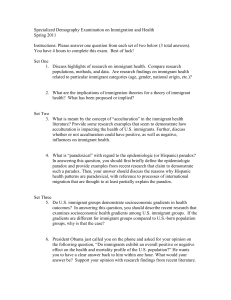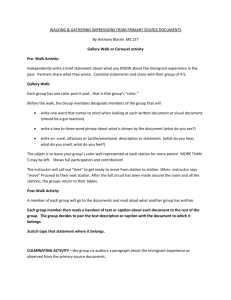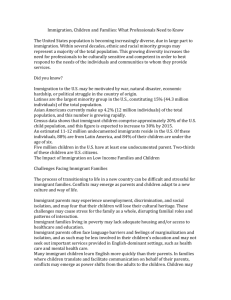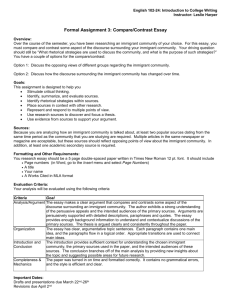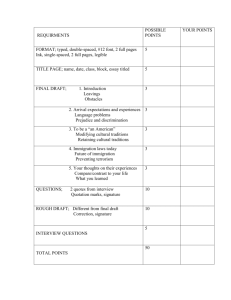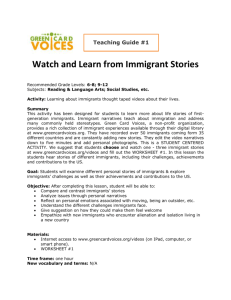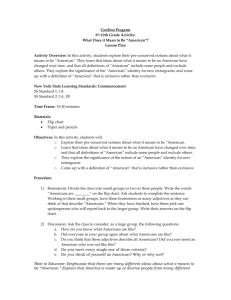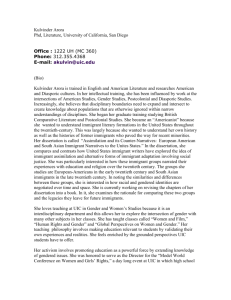Reorganization of Gender Relations among East European
advertisement
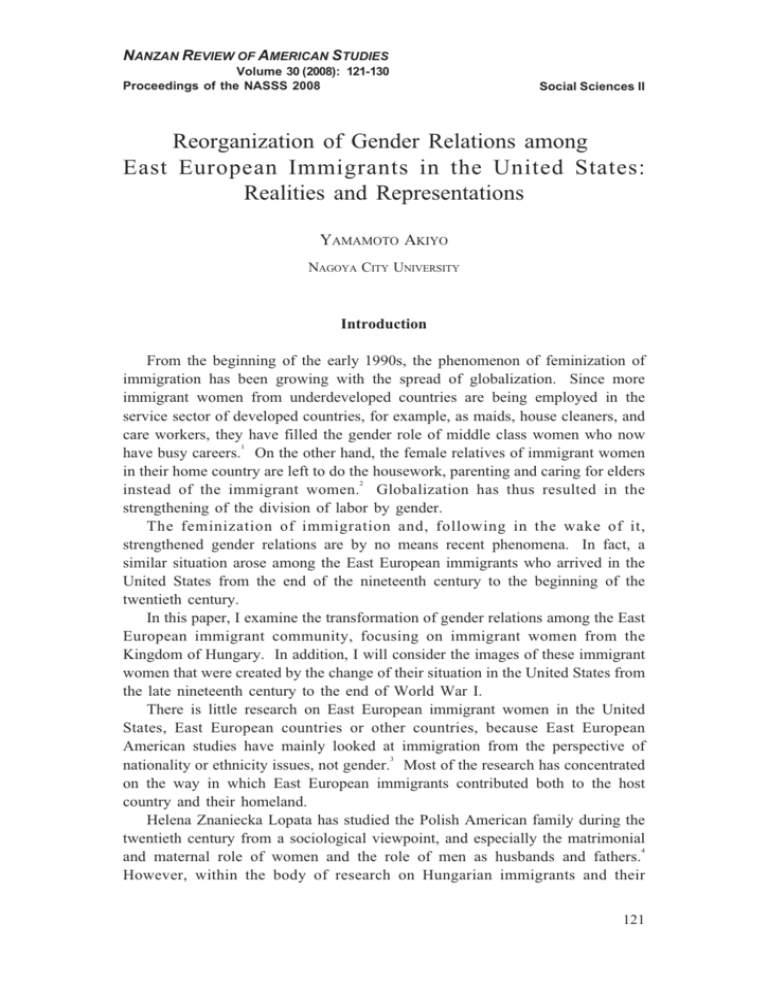
NANZAN REVIEW OF AMERICAN STUDIES Volume 30 (2008): 121-130 Proceedings of the NASSS 2008 Social Sciences II Reorganization of Gender Relations among East European Immigrants in the United States: Realities and Representations YAMAMOTO AKIYO NAGOYA CITY UNIVERSITY Introduction From the beginning of the early 1990s, the phenomenon of feminization of immigration has been growing with the spread of globalization. Since more immigrant women from underdeveloped countries are being employed in the service sector of developed countries, for example, as maids, house cleaners, and care workers, they have filled the gender role of middle class women who now 1 have busy careers. On the other hand, the female relatives of immigrant women in their home country are left to do the housework, parenting and caring for elders 2 instead of the immigrant women. Globalization has thus resulted in the strengthening of the division of labor by gender. The feminization of immigration and, following in the wake of it, strengthened gender relations are by no means recent phenomena. In fact, a similar situation arose among the East European immigrants who arrived in the United States from the end of the nineteenth century to the beginning of the twentieth century. In this paper, I examine the transformation of gender relations among the East European immigrant community, focusing on immigrant women from the Kingdom of Hungary. In addition, I will consider the images of these immigrant women that were created by the change of their situation in the United States from the late nineteenth century to the end of World War I. There is little research on East European immigrant women in the United States, East European countries or other countries, because East European American studies have mainly looked at immigration from the perspective of 3 nationality or ethnicity issues, not gender. Most of the research has concentrated on the way in which East European immigrants contributed both to the host country and their homeland. Helena Znaniecka Lopata has studied the Polish American family during the twentieth century from a sociological viewpoint, and especially the matrimonial 4 and maternal role of women and the role of men as husbands and fathers. However, within the body of research on Hungarian immigrants and their 121 YAMAMOTO AKIYO descendants, women’s history has received little attention. Likewise, research on Hungarian immigrants in the United States has hardly touched on the role of women in the immigrant and wider community. In this paper, I will firstly describe various aspects of the reality of East European immigrant women and, secondly, try to analyze the images and representations of them in each period. Gender order penetrates politically, economically, and culturally into immigrant society, and it influences and reinforces itself in the society. Therefore, for an examination of the gender relations of the immigrant community, it is necessary to investigate both realities and representations. I. Departure from Rural Society in the Kingdom of Hungary The immigrants from the Kingdom of Hungary consisted of people from ethnically and religiously plural rural societies. From the late nineteenth century to World War I, it has been estimated that about two million people immigrated to the United States. These people belonged to various ethnic and religious groups: Magyar, Slovak, Rusyn, German, Roman Catholic, Greek Orthodox, Greek 5 Catholic, Reformed, Lutheran, and Jewish. Until the twentieth century, most of the immigrants from Hungary were unmarried men, or men unaccompanied by their families. But after 1911 the number of immigrant women grew gradually, so that by the eve of World War I, the number of women immigrants exceeded that of men. The increase in the number of young, unmarried immigrant women and of men bringing their wives 6 back to America was main cause of this demographic trend. As a consequence of the growing number of immigrants from Hungary, immigrant communities began to be formed in the cities in the East and the Midwest of the United States and a chain migration system expanded and became stabilized. This made it easy for immigrant women to journey to the United States, take up residence and search for a job. A. Chain Migration and Family Networks As an example, I will describe a case of chain migration and family networking among the immigrants from rural Hungary. One woman who would later become an immigrant was Sedlock (Sedlák) Mária. She was born in Abaúj7 Torna prefecture in the northeast of the Kingdom of Hungary. After the Hungarian Revolution of 1848 and the declaration of manumission, the feudalistic social structure was gradually dismantled during the second half of the nineteenth century. As a result of this change, Mária’s father became a day laborer after many years of working as a farm laborer with a status not much different from that of a serf. But the situation of her family changed for the worse with the death of her father. Mária started to work as servant girl for a wealthy Jewish family in a neighboring village in order to contribute financially to the household and save 122 Reorganization of Gender Relations among East European Immigrants in the United States for her own dowry. At first, her eldest brother left for the United Sates and he was followed by another brother. When the eldest brother returned home for a temporary visit, Mária decided to go to the United States. On her brother’s return, he brought her to Mingo Junction in the State of Ohio. The community at Mingo Junction was composed of immigrants who hailed from the same villages in Hungary. There her brother worked in a steelworks, while Mária took a job as a servant girl in Steubenville located near the city. One year later, she met and married a man at Mingo Junction who was from a neighboring village in Hungary. She was not a so-called “mail order bride” like many of the immigrant women arriving at the Bohemian communities in the states of the Midwest and the West. Mária, it is thought, met her husband through an introduction by her brother, who was living in Mingo Junction at that time, after she went to America. Alternatively, their meeting may have been by chance. Although in small communities such as Mingo Junction endogamy was common, marrying people from the local community was much less prevalent in large cities. This was shown by research carried out by Puskás Julianna and Fejös Zoltán amongst members of the Hungarian Protestant Church in New Brunswick 8 (in New Jersey) and Chicago. This case study of Sedlock Mária, who, as we have seen, worked as a servant girl before and after immigration and married a “local man” from her home country, typifies how the customs and networks from the home country were transplanted to America. At that time in the Kingdom of Hungary there was a shortage of women to work in light industries and as servants in the areas of the Kingdom with immigrant sending communities. Women begin to immigrate not just to follow their men folk, but to make their own fortune and carve out a future for themselves. B. Bringing Wives to the United States Most Hungarian immigrant men arrived on American shores alone because their main purpose was that of saving money to purchase a piece of land or start a small business back in their home countries. Although they had not made a final decision to settle in the United States, they still brought their wives over in order to save as much money as possible in a short period. They sent letters to their wives to encourage them to come to the United States. In these letters, husbands would write instructions and advice on the handling of the family’ s land, preparing for departure, and packing belongings. They would even instruct their wives on how to prevent baggage theft at the port. In most cases, husbands bought a ticket or sent money for their wives to purchase a ticket. But in one of the letters a husband wrote that he had only lent the money to his wife for the ticket, and he reminds her that, after saving money 9 in the United States, she will have to pay back the money. In those days the 123 YAMAMOTO AKIYO relationship between husband and wife was based on household finance rather than affection. II. East European Immigrant Women in the United States A. Saving Money for Family and Crisis Management As mentioned above, the purpose of bringing the wife to America was for domestic and financial reasons. When the couple had no children, the wife worked in light industrial factories. However, if they had children or there were not suitable factories in that city, they took in boarders. It was typical for the husband to work in a factory or mine, while the wife provided the meals, washed the clothes, and cleaned the room for the boarders. The income from boarders served a vital function because it provided some degree of financial security, if the husband lost his job. Compared to before immigration, immigrant women in America played a much more significant role in the family economy. Before coming to America the women, as we saw in the example of Mária, worked to save money for their dowry or to contribute to the household budget, but after arriving in America, they began to play a more 10 important role as breadwinners and as contributors to family savings. The advances for women were not only welcome ones: the women often had to endure sexual advances. In one case, a woman who shared her cramped two or three room house with 6-8 boarders and an equal number of children was forced to permit her boarders to have glimpses of the most intimate details of conjugal 11 life. She was often forced to walk undressed among them. One boarding house used the catchphrase “sexual service” in an advertisement to attract boarders. Such cases of sexual harassment and “sexual service” in boarding houses emphasize the point made previously that the relationship between husband and wife in those days was one based on the economy of the household. Providing “sexual service” was necessary for the survival of East European immigrant poor in the United States. While enduring the agony of this inner conflict, immigrant women looked for a way to survive. B. Servant Girl and Factory Worker Unmarried immigrant women worked as servant girls and factory workers. In the United States, being a servant girl was part of the life cycle among women from low income classes. They worked in the homes of wealthy American families as room maids and cooks. During their service, they had contact with the American middle class lifestyle. The cooks made a kind of fusion food, adopting Hungarian dishes to the American palate. After getting married usually with a factory worker, the women resigned from servant girl work to take care of their family and boarders. Immigrant women also worked in light industries, food processing, cigar and tobacco establishments, men’s and ladies’ garment factories, and so on. Factories 124 Reorganization of Gender Relations among East European Immigrants in the United States employing women workers paid most of them 40-50 cents per day for the 8 hours of work as prescribed by law. This price was one fourth or fifth that of male 12 workers. The jobs of servant girl and factory worker were both low skilled and low paid, but, given the choice, young immigrant women generally preferred factory work, because it was less restrictive socially and gave the women more free time. In their free time, women factory workers usually participated in fraternal or religious associations in their immigrant communities. C. Images of East European Immigrant Women In the early twentieth century, East European immigrant women were looked upon as aliens from another planet. The immigrant women dressed in peasant clothing when they arrived in the cities as compared with immigrant men who wore secondhand jackets or suits instead of peasant clothing. A Czech woman remembers how “the Americans looked upon us with distrust or rather aversion. Later I learned it was only our customs―our bare feet and handkerchiefs over our 13 heads―that they objected to.” American middle class women viewed immigrant women as “others”, not only because of their clothes, but also due to differences in their customs, religion, language, social status, and so on. During the Homestead Strike of 1892, the image of East European immigrant 14 women became much worse. East European workers took part in a strike under the command of the Advisory Committee and for the first time organized a union: the Lodge of the Amalgamated Association of Iron and Steel Workers. American workers did recognize the contribution of immigrant workers, but generally did not regard the immigrants as equals. This was shown during the strike when the immigrant workers were positioned in the most dangerous position on the front line. Their unequal treatment during the strike reflected the immigrants low position in the hierarchy of the workplace. In this strike, East European immigrant women were confronted by security guards of the Pinkerton National Detective Agency, who were sent by the Carnegie Steel Company to put down the strike. The Pittsburgh Post reported that most of women who had gathered on the banks of the Monongahela River to hurl stones at the guards were “Hungarian”. During the strike, what was called “savageness” and “uncivilized behavior” by East European immigrant workers got full coverage in the papers, and East European immigrant women got much worse press than their male compatriots. “It was the ‘Hungarian’ women who were the most violent. They seemed ‘worse than the men’,... They gathered around and tore the clothes from the backs of the agents... Women and girls... with sticks and clubs beat the poor wretches. One woman had a stocking filled with iron, and with it she struck one 15 of the Pinkerton men over the head.” East European immigrant women were positioned around the periphery in Homestead where the Carnegie Steel Company was of central importance to the economy, and where there were few jobs for women. As I have mentioned, East 125 YAMAMOTO AKIYO European immigrant men organized the lodge of the Amalgamated Association of Iron and Steel Workers and pledged loyalty to the union. In contrast to the men, the activities of East European women were not under control of the union. Therefore, immigrant women were seen as being much more violent and irrational than men. The “invisibility” and “otherness” of the immigrant women emerged in the male-led steel town. III. World War I and East European Women A. Loyalty to America and the Homeland Cause A great influence on East European communities in the United States was the entry of the country into the First World War in April 1917. The war provided a good opportunity for the Polish, Czech and Slovak peoples to gain independence and this long-held dream for independence was supported by compatriot immigrant communities in America. They formed a volunteer army which was sent to the western front. At the same time, they eagerly backed the Liberty Bond 16 Campaign to support the war. On the other hand, the Hungarian Community, because it faced the danger of being treated as enemy aliens like the American Germans, faced a more complicated situation following the United States’ declaration of war against 17 Austria-Hungary. During the war, some leaders in the Hungarian community advocated the unilateral independence of Hungary from Austria without consideration for Czech and Slovakia. These countries had in turn been demanding liberation of their homeland from Austria-Hungary. The leaders of the Hungarian immigrant community emphasized to President Wilson how Hungarians were being oppressed by Germans in Austria. In this way, they sought to escape being labeled as enemy aliens. It was necessary for the Hungarian Community to express their enthusiastic loyalty to the United States by participation in Loyalty Parades and by buying Liberty Bonds. Hungarian immigrant women started to play an active part in their community, workplace, and the Americanization movement. B. Immigrant Women and the War The wartime demand for increased goods and munitions created an industrial boom. In Cleveland, Ohio, with over 40,000 men in the armed services, and with the shutting off of the immigrant flow from Europe, there developed a critical labor shortage. To fill the vacancies, women were encouraged to give up 18 housekeeping for factory work. A shortage of male workers meant women workers being employed in steel mills, electric railways and motor companies, and on street railways as conductors. From early in the nineteenth century, American born white middle class women had begun to engage in volunteer activities for the church, but it was during the First World War when Hungarian immigrant middle class women 126 Reorganization of Gender Relations among East European Immigrants in the United States really started to organize volunteer activities. Before World War I, the organizations formed by East European immigrant women merely belonged to fraternal associations or lay assemblies which were controlled by men. The war opened up the activities of women’s associations. For example, Hungarian women held a bazaar to support war widows, orphans and prisoners of 19 war in Siberia. The Loranffy Zsuzsánna Society, organized by female members of the Cleveland Hungarian Reformed Church, supported not only war widows 20 and orphans, but also sick and poor immigrants. The president of the society, the Hungarian consul’s wife, together with an all female board ran the society themselves. In 1918, the Fraternal Mutual Aid Hungarian Women’s Society put on a charity dance and made a donation to the U. S. Red Cross. C. The Americanization Movement In Cleveland, the mayor organized a War Advisory Committee to plan war 21 activities for the city. The Women’s Committee of the Council of National Defense was formed to promote Liberty Bonds and the Americanization of foreign women. The Committee also organized citizenship classes. Also in Cleveland, an Americanization Committee was formed by Raymond Moley, a university professor, to hasten the nationalization of aliens in the city and to organize ethnic community leaders. It was the influence of the Americanization Committee that led to the Federation of Women’ s Clubs accepting women’ s organizations that represented foreign born women, for example, the Polish Cultural Society, the Lithuanian Catholic Women’ s Benefit Society, and the 22 Italian Women’s Club. Apart from the Federation of Women’s Clubs, most of the members of the Americanization Committee were men, but in the field of English education, middle class women did remarkable work. For example, the Hungarian immigrant, Helen Horvath, promoted sensitive Americanization as a means of combating the intolerance of more established 23 immigrants through her “Speak United States”, “See United States” philosophy. She encouraged newcomers to remember their own culture while learning enough about America to exploit its opportunities. After coming to Cleveland in 1897, she studied English and started language classes for other immigrants based on her own experience. By World War I, at the height of the anti-immigrant hysteria, the Cleveland Board of Education brought her and her adult education program into the city system and authorized her to open new schools. D. Women’s Image in War Bonds Campaigns Before the United States declared war against Austria-Hungary, the Hungarian Community in the United States supported Hungary by buying Hungarian war bonds. The campaign encouraged the Hungarian community to purchase 24 Hungarian and American war bonds by using various representations of women. The campaign for the Hungarian war bonds, for example, exploited images of war widows and orphans. Longing for the independence of Hungary, the members of 127 YAMAMOTO AKIYO the Hungarian community could not accept the appeal for support of the Austrian government under whose rule the Hungarian people lived. The plight of war widows and orphans had become an issue of public concern in Hungary and the campaign images of war widows and orphans exerted a great influence on the community’s sentiments and the senses of the immigrant men who had left their families in their homeland. With a situation of ever-increasing participation by women in public affairs during the war, both representations strengthened the gender order that had existed hitherto, and rallied members of the community by means of connecting sentiment toward war widows and orphans with nationalistic feelings. Before the war, the Hungarian community had paraded only to commemorate memorial days marking the Hungarian Revolution of 1848. However, after the declaration of war against Germany, they actively began to participate in the parades that took place on national holidays, for example, Flag Day and Independence Day, as a way to show their loyalty to America. The immigrant women changed their attire from an Americanized version of Hungarian folk costumes, worn pre-war, to pure white clothes that represented both the role of a nurse that women were encouraged to perform during the war, and also their pure loyalty to the United States. Conclusion In this paper, I have analyzed the transformation of gender relations among the East European immigrant community, focusing on immigrant women from the Kingdom of Hungary. I considered the kinds of images of these women that were created as their situation in the United States changed from the late nineteenth century to the period of World War I. Most East European immigrant women made use of the social network in their homeland to come to the United States. After arriving at the United States, they continued to use the network, but to survive they had to change their customs and values. The role of immigrant women was still played according to the sexual division of labor that belonged to the private sphere. At that time, their presence was so invisible to American society that many Americans regarded immigrant women as “others” and saw their behavior during the steel strike as even more savage than their male immigrant compatriots. World War I brought East European immigrant women much greater scope for increased activity than American born women. They took on roles not only in their communities and workplaces, but also in local war campaigns as members of organizations selling war bonds, and in the English teachers for Americanization movement. Although on one hand, they had begun to participate in the public sphere, on the other, discourse on and representation of East European women portrayed them as victims of war and the object of relief, and as existing under the patronage of men. Despite their increasingly active role in society, the 128 Reorganization of Gender Relations among East European Immigrants in the United States overarching gender order did not radically change. Nevertheless, relations between men and women in the East European community were gradually transformed by the wartime social participation of women. After World War I, women began to take the initiative in the activities of East European communities, where, with the growth of leisure time, dance parties and picnics flourished. Gone were the days of small girls wearing the national costume sitting around a model of the Statue of Liberty, typical of the parades of East European immigrants before World War I; beauty queens chosen in immigrant communities were now given center stage on national days, in parades 25 and pageants. Notes 1 Sato Chitose, “Gender and Work in the New Economy”, Chiba University 21th Century COE Program International Symposium, “The New Economy of the United States: Possibilities and Anxieties”, December 15 and 16, 2007. 2 Rhacel Salazar Parrenas, “The International Division of Reproductive Labor, Servants of Globalization: Different Settings, Parallel Lives”, In: Rhacel Salazar Parrenas, Servants of Globalization: Women, Migration and Domestic Work, Stanford University Press, Stanford, California, 2001. 3 Julianna Puskás, Ties that Bind, Ties that Divide: One Hundred Years of Hungarian Experience in the United States, Holmes & Meier, New York & London, 2000. 4 Helena Znaniecka Lopata, “The Polish-American Family” , In: Charles Mindel (ed.), Ethnic Families in America: Patterns and Variations, Prentice Hall, Saddle River, New Jersey, 1998, pp. 128-152. 5 Yamamoto Akiyo, “A Study on the Process of the Formation of Immigrant Groups from the Kingdom of Hungary to the United States: Church, Family, Workplace and Ethnic Groups.”, Ph. D. dissertation, Chiba University, 2001 (in Japanese). 6 Puskás Julianna, Kivándorló magyarok az Egyesült Államokban 1880-1940, Akadémiai Kiadó, Budapest, 1982, p. 82. 7 Albert Tezla (ed.), The Hazardous Quest: Hungarian Immigrants in the United States 1895-1920: A Documentary, Corvina, Budapest, 1993, pp. 161-171. 8 Puskás (2000), op. cit., p. 49; Fejo" s Zoltán, A Chicagói Magyarok Két Nemzedéke 1890-1940, Közép-Európa Intézet, Budapest, 1993, pp. 277-278. 9 Szili Ferenc (szerk.), Kivándorló a Délkelet-Dunántúlról Horvát-Szlavónországba és Amerikába 1860-1914, Somogy Megyei Levéltár, Kaposvár, 1995, pp. 188-242. 10 Yamamoto (2001), op. cit, p. 90. 11 Tezla, op. cit., pp. 401-402. 12 Ibid., p. 400. 13 Thomas F. Campbell & Edward M. Miggins (eds.), The Birth of Modern Cleveland, 1865-1930, Cleveland, Western Reserve Historical Society, Associated University Presses, London, & Toronto, 1988, p. 107. 14 Yamamoto (2001), op. cit., pp. 74-86. 15 Pittsburgh Post, 7 July, 1892. 16 Nakano Kotaro, “Homeland Nationalism and American Patriotism: Polish Immigrants in 129 YAMAMOTO AKIYO Chicago”, In: Higuchi Hayumi & Chujo Ken (eds.), American Histories: Narrating the Routes to Nationhood, Sairyusha, Tokyo, 2006, pp. 247-273 (in Japanese). 17 Yamamoto Akiyo, “World War I and Reorganization of Immigrant Community: Immigrants from the Kingdom of Hungary in the United States” , the 57th Conference Symposium of the Japanese Association for Studies in Western History, “Nation-State and Multiple Identity: Empire, Nation and Ethnic Group in Central Europe”, June 16, 2007. 18 Campbell, op. cit., p. 315. 19 A Miniszterelnökség központilag iktatott és irattározott irata (The centrally registered and filed documents of the Prime Minister’s Office), OL-ME-K26-1916-XXI-2022, p. 38. 20 Ibid, p. 17. 21 Campbell, op. cit., p. 315. 22 Cleveland Americanization Committee of the Mayor’s War Board, Americanization in Cleveland: An Account of the Work which has been done in Cleveland to Develop and Maintain City Morale, Cleveland, Ohio, [1920?]. 23 Susan M. Papp, Hungarian Americans and their Communities of Cleveland, Cleveland Ethnic Heritage Studies, Cleveland State University, Cleveland, Ohio, 1981, pp. 214-218. 24 Yamamoto (2007), op. cit. 25 Yamamoto Akiyo, “The Formation of Hungarian Ethnicity in the United States: The Movement to Erect the Statue of Kossuth Lajos in Cleveland”, Slavic Studies, No. 45, 1998, pp. 197-219 (in Japanese); Yamamoto Akiyo, “Chicago’ s 1933-34 World’ s Fair and Hungarian American Culture”, Historical Science Review (Rekisi Hyoron), No. 658, 2005, pp. 58-71 (in Japanese). 130

